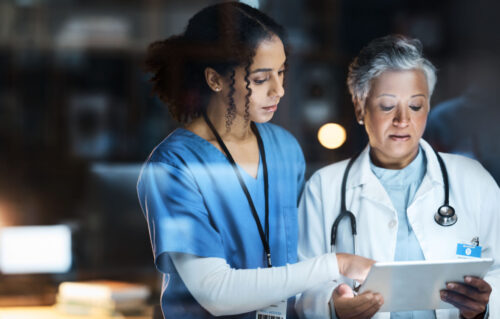
Talk with a ChartSpan Representative Today!
Our team is ready to help you improve patient care and outcomes.
Blog
Access to Care and Chronic Care Management
According to the Centers for Disease Control & Prevention (CDC), 68% of Medicare patients have two or more chronic conditions. However, many patients with chronic illnesses don’t have access to the care they need, which can have devastating consequences for their health.
By giving patients remote, preventative care every month and making it easier for them to stay in touch with their providers, Chronic Care Management (CCM) can improve access to care for patients with chronic conditions. We’ll discuss some of the challenges that stand in the way of access to care, and how CCM can help your practice overcome them.
Challenges in Accessing Care
Preventative care can help patients reduce their rates of hospitalization and emergency department visits. However, a patient's ability to access care depends on a range of socioeconomic factors known as Social Determinants of Health (SDOH). The U.S. Department of Health & Human Services's Healthy People 2030 initiative lists the following as the top five SDOH domains:
- A patient's economic stability
- Access to quality education
- Access to quality health care
- Neighborhood and built environment
- Social and community context
Out of these five, a patient's economic stability — specifically, lack of access to adequate health coverage — is the largest barrier to care access. According to the U.S. Department of Health, about one in every 10 Americans is uninsured. Though Medicare beneficiaries have insurance, they may still struggle with the cost of copays, medication, or transportation.
A lack of access to reliable transportation or a fear of copays can lead patients to delay or cancel important appointments, and the cost of medication can lead patients to skip doses or stop taking a medication altogether.
As a result, many patients must seek emergency treatment for conditions that could have been managed through preventative care. From 2017 to 2019, 61.5% of adult emergency department visits were made by patients with one or more chronic diseases.
Chronic Care Management cannot eliminate all socioeconomic barriers to care. However, CCM care managers can screen patients for SDOH needs. If they identify that a patient is struggling economically, they can direct them to resources like transportation services, food pantries, clothing closets, housing agencies, and affordable medication programs.
CCM programs also help patients build strong connections with their primary care provider. Patients are then more likely to attend preventative care appointments and take action to improve their health outcomes.
New Advances in Healthcare Access
While the COVID-19 pandemic highlighted the cracks in health care inequity, it also sparked positive changes in access to care by prompting many practices to take steps toward a digital transformation. Telehealth, for example, evolved from a temporary solution into an effective way to provide care to patients when they can’t find transportation or take time off to visit their provider’s office.
Remote care can also complement in-person appointments. For example, Chronic Care Management provides remote care via phone, email, or text in between regular visits. CCM care managers can then direct patients back to their provider’s office for vaccinations, screenings, and regular visits, and help them arrange transportation to get there. As remote care becomes more common, preventative care becomes more accessible.
How to Improve Access to Care for Your Patients With CCM
When you implement a CCM program, you need to make it accessible for your eligible patients. Cost, convenience and availability all play critical roles in making care accessible.
1. Cost
ChartSpan’s claims data shows that patients enrolled in CCM have a 21% reduction in overall healthcare costs, a 52% reduction in 30-day hospital readmission rates, and a 36% reduction in inpatient hospitalization costs.
Though CCM does have a coinsurance cost for patients, some patients are eligible for financial assistance. For patients who aren’t, CCM can still reduce their overall healthcare costs by lowering their risk of hospitalization.
2. Convenience and Availability
Patients who have busy schedules or need assistance after-hours may find it difficult to access care and be forced to resort to the emergency room, even for non-emergencies. Providing a 24/7 support line, as CCM does, makes it possible for patients to ask questions and receive the care they need after hours. The CCM care team can notify your practice of the patients’ needs or direct them to emergency services, if necessary.
Improve Access with the Right Technology
Remote preventative care is reliable, quick and convenient for patients who may experience difficulties making it to face-to-face appointments every month. However, for many patients currently aging into Medicare, technology can be a barrier to receiving the proper care. That's why it's best to avoid overly complex apps and software platforms that could discourage patients from seeking help.
Make sure any remote communication solution you choose is user-friendly and designed with accessibility in mind. A CCM program is an excellent way to ensure your patients are getting the remote care they need between visits. A good CCM program will include multiple modes of communication, so patients can choose one they’re comfortable with. In addition to monthly calls and a 24/7 phone line, a CCM program should offer options like SMS texting, direct mail, and email.
Provide Services that Increase Healthcare Access
Whether you're creating an in-house CCM program or partnering with a trusted CCM service, your focus should be on creating a welcoming, supportive patient experience.
Providing assistance with the following can enhance patients’ access to healthcare and help keep them engaged:
- Regular check-ins: Conducting remote check-ins with your patients at times that suit their schedules is a great way to make healthcare more accessible. ChartSpan offers call scheduling so patients can decide when they’d like to hold their CCM calls each month.
- Education: To make healthcare more accessible, patients need literature and materials that are easy to understand, written in their preferred language. Effective CCM programs provide peer-reviewed educational collateral via email, text, or mail so patients can improve their self-management and know what questions to ask about their care.
- Care plans: CCM programs must give patients access to their care plan. One of the easiest ways to do this is through an online portal, though email, texting, and direct mail are also options.
- Appointment assistance: Patients might skip appointments because they forget, have an unexpected conflict, or lack transportation. CCM care managers can help by directing patients to transportation agencies or rescheduling appointments when needed. Care managers can also synchronize records from patients’ primary care and specialists’ offices so they can remind patients of multiple upcoming appointments.
- Medication refills: Sometimes, patients cannot access the medications they need due to cost, difficulty reaching the pharmacy, or confusion over what to refill and when. Care managers can remind patients which medications need refills, help them set up home delivery, and check on whether patients are taking medication as prescribed.
Through regular check-ins, educational materials, care plans, and assistance with appointments and medications, CCM services can give Medicare patients easier and more consistent access to care.
Work With a Fully-Managed CCM Provider
ChartSpan is the largest fully-managed CCM service in the country. Our turnkey care coordination program helps healthcare providers improve patient outcomes and increase access to quality care while simultaneously increasing practice revenue.*
We strive to improve health outcomes by increasing engagement between providers and patients. When you choose to implement a CCM program with ChartSpan, we'll take the workload off your staff's shoulders so you can focus on the everyday responsibilities of running your clinic.
Most practices that attempt to implement an in-house CCM program only manage to enroll about 10% of their eligible patients. On average, ChartSpan averages 45% enrollment for the clinics and health systems we work with.
ChartSpan provides end-to-end support for many types of practices, from primary care providers to specialty practices, Federally Qualified Health Centers and Rural Health Clinics. We handle the CCM process from start to finish so you can tend to your patients without interruption to your daily workflows.
*Results may vary by provider.
Contact ChartSpan for More Information
Partnering with ChartSpan opens access to Chronic Care Management for all of your eligible patients. Our expert care staff will become an extension of your care coordination team, so your patients with chronic conditions have access to clinicians whenever they need it.
Check out our latest claims data to see how a CCM program can help you reduce patients’ hospital readmissions and ER visits and improve their overall health outcomes.
Subscribe for More Insights
Get valuable resources delivered straight to your inbox.
"*" indicates required fields






